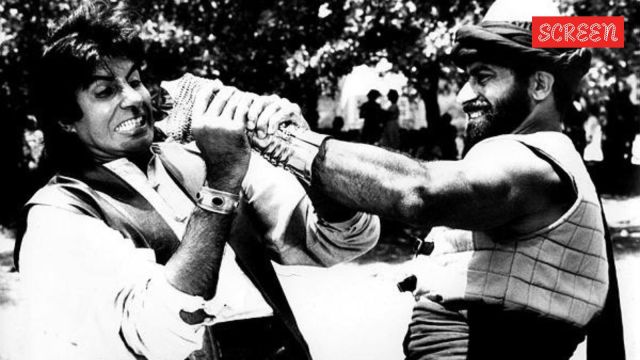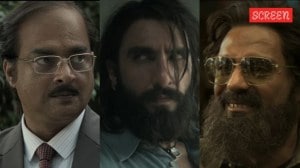Click here to follow Screen Digital on YouTube and stay updated with the latest from the world of cinema.
Bollywood’s infamous villain’s henchman, body double to Amitabh Bachchan, met an untimely end at just 37
Manik Irani earned significant recognition as a character actor and stunt double, rising to immense popularity after his memorable role in Subhash Ghai’s Hero. However, his life was tragically cut short due to complications from alcoholism.
 Manik Irani was Amitabh Bachchan's body double in films like Don and Trishul.
(Photo: Express Archives)
Manik Irani was Amitabh Bachchan's body double in films like Don and Trishul.
(Photo: Express Archives)Long before stunt performers were credited or celebrated, Bollywood’s high-octane action scenes were shaped by unsung heroes behind the camera. Among them was Manik Irani, a dedicated stuntman and character actor who spent much of his career doubling for Amitabh Bachchan and supporting villains in classic Hindi cinema. Born on October 23, 1953 into a Parsi family in Mumbai, Manik Irani was fascinated by physical strength from an early age. Inspired by wrestling icon Dara Singh, he was drawn more to bodybuilding and physical training than to academics. But unlike most young men dreaming of stardom, Manik had a different ambition: he wanted to be a stuntman.
That dream began to take shape when he started boxing on the streets and came into contact with MB Shetty, a prominent action director and stunt coordinator of the time, and father of filmmaker Rohit Shetty. Impressed by Manik’s skills and physique, Shetty invited him to join his stunt team. It was a turning point Irani had long waited for, and he joined without hesitation. It was as if his story was already being written by fate. Manik Irani entered the film industry at a time when romantic heroes were fading from the spotlight. Rajesh Khanna, Hindi cinema’s first superstar, was losing his hold on audiences, while a new, brooding force named Amitabh Bachchan was rising rapidly with his portrayal of gritty, simmering anger.
 Jeetendra and Manik Irani in the film Mar Mitenge. (Photo: Express Archives)
Jeetendra and Manik Irani in the film Mar Mitenge. (Photo: Express Archives)
Manik Irani bore a close resemblance to Amitabh Bachchan in height and build, which made him a natural choice as Bachchan’s body double in iconic films such as Deewaar, Trishul, and Don. His official Bollywood debut came in 1974 with a small role in Paap Aur Punya, and he continued to appear in several films throughout the ’70s, often as a henchman in the villain’s gang. In Deewaar (1975), he appeared as one of Peter’s men in the warehouse fight scene. In Trishul (1978), he was again seen in the thick of the action. Perhaps one of his most physically striking moments came in Kalicharan (1976), where his lean, agile frame and martial arts skills drew comparisons to Bruce Lee during a fight sequence with Shatrughan Sinha.
 Manik Irani was supposed to work on another film with Chandra Barot titled Boss, starring Vinod Khanna, but the project was eventually shelved. (Photo Express Archives)
Manik Irani was supposed to work on another film with Chandra Barot titled Boss, starring Vinod Khanna, but the project was eventually shelved. (Photo Express Archives)
For years, Manik Irani’s roles remained small, often uncredited. But that changed with Mr. Natwarlal (1979), where he played a mute villager secretly working for the villain, essayed by Amjad Khan. It was a modest role, but one that gave Manik visibility. From the 1980s onward, he began receiving roles with dialogues and distinct screen presence. Manik adopted a more fearsome look in the early ’80s, growing a full beard, bulking up, and sporting an intimidating smile that left an impression. He then appeared in major big budget films of that decade, including Shaan (1980), Naseeb (1981), and Silsila (1981).
After collaborating with Don filmmaker Chandra Barot, Manik Irani was set to appear in his next project, Boss, alongside Vinod Khanna. However, the film was eventually shelved. It was finally Subhash Ghai’s Hero (1983) that gave Manik the screen identity that stuck for life. He played a menacing goon named Billa, and though Jackie Shroff was the film’s breakout star, the name of Manik’s character became so popular that it became his off-screen identity too. From then on, he was known as “Billa” — both in the industry and among audiences. Among his notable roles in the 1980s were his portrayal of Zebisko in Manmohan Desai’s Mard (1985) and the monster in the Ramsay Brothers’ Purani Haveli (1989).
 Manik Irani and Nagarjuna in film Hero. (Photo: Express Archives)
Manik Irani and Nagarjuna in film Hero. (Photo: Express Archives)
Although Purani Haveli didn’t make a major mark at the box office, it marked a departure for Manik Irani. Playing the monster in the horror film allowed him to break away from the stereotypical villainous characters he was known for. He had already begun moving away from his established image, exploring different shades on screen over the years, occasionally taking on positive roles, most notably in Vishwanath (1978) and Aamne Samne (1982). He also made a rare appearance in Marathi cinema with Maal Masala (1992), where he was credited as “Black Belt Champion Manik Irani” in a comedic karate instructor role alongside Ashok Saraf.
 Mohsin Hassan Khan, Manik Irani and Anil Kapoor in film Pratikar. (Photo: Express Archives)
Mohsin Hassan Khan, Manik Irani and Anil Kapoor in film Pratikar. (Photo: Express Archives)
Manik remained active in films well into the early ’90s, starring in films such as Chor Pe Mor (1990), Baap Numbri Beta Dus Numbri (1990), Farishtay (1991), Saugandh (1991) and Deedar (1992), the latter two featuring a young Akshay Kumar. But fame brought with it a personal struggle. Manik reportedly became a heavy drinker, and despite being warned after a jaundice diagnosis, he continued to consume alcohol. His fitness declined, and he began to appear visibly heavier in his later roles. Tragically, he passed away on June 16, 1991, at the age of 37.
News of his death remained relatively unknown at the time. Films featuring him continued to release posthumously, including Talaashi (1996) and Badla Aurat Ka (2001), leading some to mistakenly believe he was still alive. Though never a leading man, Manik Irani lived the life he aspired to. In an industry dominated by stars, he managed to carve out a unique space for himself.
- 01
- 02
- 03
- 04
- 05


































